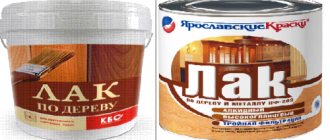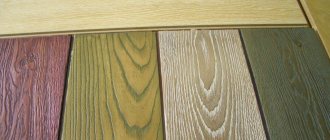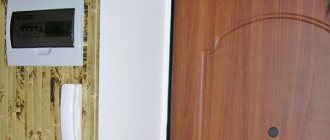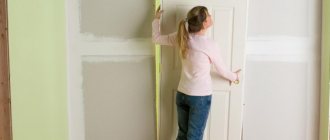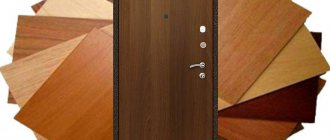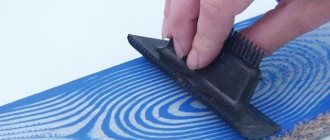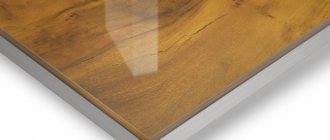Processing wood with stain
To age a door leaf with your own hands, you will need a water-based stain solution.
The process itself looks like this:
- The wood is covered with a main layer of dye.
- Using a sponge, wash off the freshly applied stain. But only certain areas (the central part of the canvas) are processed: corners, cracks and edges are not touched. Using a small brush, the depressions are additionally treated with stain.
- As soon as the wood dries, apply a finishing layer of stain (this time using a white spirit-based coloring composition). Then wait until the workpiece dries.
- Using a brush or sponge, cover the door leaf with alkaline primer. This composition allows you to fix the color of the joinery.
- Apply antique wax to the surface and rub it in lightly. To do this job you will need a special metal brush.
The antique door obtained using this method looks amazing, and the effect lasts for a long time.
Preparatory work
Before starting work, you should remove the doors from their hinges and place them horizontally on a hard surface. Two stools are suitable for this purpose. Then, using a hair dryer, you need to remove the old paint. How to do this? By heating paint, which will swell under the influence of temperature. Now it can be easily removed with a spatula.
The next step is to seal all the gaps, cracks and potholes formed during operation. To do this, you will need putty, the color of which should be close to the shade of the wood.
Ideally, use a furniture varnish based on beeswax. It is not cheap, however, if you want to make your entrance doors beautiful, reflecting the color and texture of natural wood in its full glory, then you should not skimp on finishing materials.
The final stage is sanding. In order for the paint to lie smoothly in the future, you need to polish it thoroughly. Doing this by hand is difficult and time-consuming, so a grinding machine will help. Now you need to decide how to decorate the door.
Brushing
The main tool used in this step is a stiff wire brush. With the help of this device, soft layers of wood are deformed and removed from the surface being treated, and the door leaf acquires a relief appearance.
As a rule, such a pattern can only be seen on old wood, but here it appears after just a few hours of work. After such rough processing, the burrs are removed using a special tool, then the joinery product is sanded and varnished.
But, unfortunately, not every type of wood can be aged using this method. For example, birch, beech and maple have a poorly defined structure, so brushing is not used for this wood. But it is better to age interior products made of pine, oak and larch using this method.
Entrance and interior antique wooden doors look elegant.
Peculiarities
You can make a door that looks antique yourself or purchase a product that is stylized as antique.
Features of such products:
All antique doors can be divided into:
Depending on the type of opening and closing, doors can be:
Sliding systems are less appropriate in a classic interior. But if there is a need to install them (there is furniture next to the opening or the entrance to another room is blocked), you should choose metal profiles in the color of bronze, brass, silver or gold.
Folding ones are also practical in terms of saving space. The narrow panels that make up such a door can be an excellent addition to the classic style.
The most classic look would be swing doors. They can be left, right or pendulum. If the room is large and the doorways are wide, you can install a double door. Since symmetry is important in a classic interior, the doors should be the same in width.
Remember the details - in this case the loops may not be hidden, but overhead. As an independent decorative element, they can also be of a certain shade, with scuffs and even imitation rust.
By type of design there can be models:
The inserts can be: glass, mirrors, stained glass, specially treated wood with metal, plastic and leather overlays. Glass can be: standard, frosted, tinted, with patterns. Patterns or pictorial images are used as drawings.
Depending on how the door surface is finished, there are:
Patination
To age interior doors made of solid maple or beech with your own hands, use the patination method. The first step is to select a paint that best matches the basic tone of the product. You need to paint the surface with this product (apply one layer). It is very important to do this work carefully: there should be no drips. Then the product is allowed to dry.
Next, wooden doors should be painted with a second coat of light-colored paint, for example, milky white. However, it is not recommended to use too bright paint, as it will reduce the “antique” effect. Then the product is left and waited until it dries.
Then take fine-grained sandpaper and sand the surface with it. As a result, the lower base will begin to appear through the top layer: it will seem as if this piece of furniture had to be painted more than once in the past, and it is already many years old.
other methods
Solid wood of beech, oak, ash and poplar is aged by chemical treatment. The door is thoroughly cleaned with fine-grained sandpaper and ammonia is applied to the entire surface. It reacts with tannins, causing darkening and brightening of the wood structure. For coniferous species, this method is unacceptable, since such wood does not contain tannins.
You can achieve a dark color and a relief structure of the fibers by singeing the door - the canvas is burned with an open fire of a blowtorch. After heat treatment, the surface is polished. The final touch is varnish or stain. Creating a rare door is an interesting and creative process; it gives you a chance to show your artistic taste and individuality. All methods of influencing wood are available at home and do not require expensive compounds and tools.
“Abrasion” of the surface of the door leaf
An antique door is created in several stages:
- It is necessary to paint the surface of the door leaf (the dye is applied evenly).
- Paraffin should be applied to individual areas of the product.
- Then you need to cover the door with another coat of paint (this time use light paint).
- Using a spatula, carefully remove the paraffin.
- Afterwards you need to sand the surface of the door leaf and cover the surface with stain.
Before installing such antique doors, you need to wait until they are completely dry.
Patination technology
This method involves using several paints with different shades. The method is not the easiest, so you will need to follow a clear sequence and rules. The work order is as follows:
- Cover with a base coat of paint. It's best to use a spray bottle, but if you don't have one, a brush will do. The main condition is not to leave streaks or drips from the brush. It will be difficult to achieve this, and some will even say that doing it with a brush or roller is simply unrealistic. Although if you want, you can do anything, you just need a little patience. After painting, the doors need to dry. It is recommended to start the next stage in a few days.
- When the surface is ready, apply the next layer of paint with a different shade. In this case, there is no need to use a spray bottle. Need a brush. It is important to apply the paint in a thin layer. You should not immerse the brush deep into the container, as drips are inevitable. The essence of these manipulations is to draw structural stripes.
- Then we wait until the paint begins to dry, but do not let it dry completely. We create abrasions using a dry rag. As a result, the lower, dark base will be visible through the light tone of the paint, which will give the door a shabby look and the feeling that it has been painted more than once, a couple of decades apart. All this needs to be opened with varnish.
Craquelure
To age a door made of solid pine or hardwood with your own hands, the following sequence of work is performed:
- The surface is covered with base paint.
- Apply a layer of craquelure varnish.
- Cover the product with paint, the color of which contrasts or, on the contrary, combines with the base.
Under the influence of craquelure varnish, the top layer of paint becomes cracked, and the surface acquires an antique effect. This antique door is an exquisite decoration for the interior or exterior.
Removing paint from outdated doors
Before making antique doors with your own hands, you first need to get rid of the previous door covering. This will require some materials and tools, depending on the method used to remove the worn surface of the wood.
There are several ways:
- Using a special wash.
- Some use a blow dryer (fan) to accomplish this mission.
- A sander or sandpaper with different grit levels is also suitable for removing the old layer of paint.
All these methods have their advantages and disadvantages. The main thing is to clearly determine which one is most suitable. To do this, you should study the technology and features that distinguish these methods from each other.
Wash
This method can be called the easiest among all valid options. Apply a solution to the entire surface to remove old paint. In this case, you must follow clearly step-by-step instructions. The process of removing the old coating involves applying a thin layer of remover and waiting a certain amount of time. The solution softens the surface and the paint becomes wet. Afterwards, it can be removed from the canvas using a scraper.
Construction hair dryer
This method of removing coating from an old door is proven and clean. But this method is rarely used in reality, because the equipment is quite expensive.
An example of removing paint with a hair dryer
Therefore, the option of cleaning interior or entrance doors from coating in this way should be considered by people who have the device.
The operating principle of the fan heater is as follows:
- The stream of hot air that comes out of a special tip is directed towards the door leaf.
- Due to the high temperature, the paint applied to the surface will swell.
- Removing paint after the entire door structure has been blasted with hot air is carried out by scraping the material with a metal spatula.
This method of cleaning the surface is quite simple; it does not require much effort or the use of many additional materials and tools.
Sander or sandpaper
A method such as using a grinding machine or sandpaper is considered the most labor-intensive.
In this case, for the best result, you should use both a machine and sandpaper. The top layer of paint is removed from the door leaf using a grinding machine.
The process of removing paint with a sander
Places of the door structure that are difficult to reach are processed manually with sandpaper. When choosing any of the three methods of removing old paint from a surface, you should carefully consider the procedure. After all, the correct start of work promises a satisfactory result in the end. The stage of removing the old coating from the surface is the most labor-intensive and dirty. Future work will be much more enjoyable.
Do-it-yourself antique wooden doors
Replacing old doors when performing renovations usually turns out to be a very expensive procedure. But if the door structure still retains its strength, there is no point in replacing it with a new one.
This especially applies to wooden products. In fact, repairing such a door is not difficult. In this case, you can get a decent effect.
Today, a rather fashionable trend in the design of interior doors is to give the effect of antiquity. This is a fairly popular trend, since an antique wooden door gives the impression of reliability and even inaccessibility. In addition, natural materials are especially highly valued at the moment.
It’s just worth noting right away that massive wooden doors are only suitable for spacious homes. If such a design looks appropriate in an apartment or house, you can carry out some interesting activities in relation to it that will allow you to get an aging effect.
Aging techniques
The front door influences the first impression of the house, therefore, in addition to the reliability and strength of the locks, the owners are concerned with its appearance. Solid wood canvas, even after many years, retains its excellent qualities and natural living beauty. Scuffs and scratches, constant companions of time, make the door less presentable, but there are ways to correct the situation and give a quality item a second life. There are five main techniques by which the door travels into the past:
- applying stain;
- brushing with a wire brush;
- use of paint and paraffin;
- patination;
- craquelure varnish.
When choosing a way to make a door look like an antique, focus on the external features of the canvas, and in the case of interior doors, on the decor of the room.
Imitation of antiquity is appropriate on swing doors; sliding or folding structures with such an effect look unnatural. Metal overlays attached to the corners and lock, as well as an unusual forged handle in the shape of a ring or an animal’s head will be an excellent addition to the decor. The style will be supported by massive canopies secured with nails with large brass heads.
Preparing the door for repair
Before any repairs can be made, the door must be removed from its hinges. It is laid so that it is strictly horizontal. Old hinges must be removed, and new ones will be attached only after completion of the basic procedures. The removed door leaf is cleared of paint. It is best to use a hair dryer for this. When exposed to hot temperatures, the paint will peel off easily.
Next, you need to cover up all the cracks that are present in the wood. For this, putty is used. It is important to choose a mixture that is similar in color to the natural shade of wood. A wooden door can be coated with furniture varnish, which is based on antique wax. The problem is that such material is expensive. But on the other hand, it can especially advantageously emphasize the wood texture.
Even before processing the door, to create the effect of antiquity, it is necessary to sand its surface. The canvas should be perfectly smooth, because then the paint will adhere best. Due to the fact that sanding by hand is difficult, it is better to use a grinder. The final touch in preparing the door leaf is the application of two layers of varnish or paint.
We violate the integrity of the layer: craquelure
There are special paints available to consumers with the effects of cracked or peeling paintwork on the surface.
Craquelure with contrasting colors
Using standard compositions, it is possible to create, on any type of structure made from a completely different material, the effect of a layer of paint that has been damaged by time.
The technology of artificially producing small and deep cracks through the use of craquelure varnish allows you to create an aging effect on the surface of any quality material. The main thing is to strictly follow the instructions for using the composition:
- the first layer of paint and varnish of any color is applied to a wood or any other surface as a base;
- the completely dried layer is covered with a finishing layer, that is, craquelure is applied.
The active components that craquelure varnish contains cover the base layer of paint and, after drying, cause the surface to crack. The aging effect of the coating looks like cracked old paint.
Craquelure in contrasting colors
Artistic decorative cracks will appear within just a few minutes. And now the antique doors are completely ready for use, oddly enough.
Vintage look of craquelure coating
There are other ways of aging wood that are similar to the craquelure effect. At the same time, there is no need to purchase craquelure varnish, which reduces the cost factor, because it is not so cheap. All methods can be reproduced with your own hands at home using practically available tools:
- PVA glue.
A fairly thick layer of PVA adhesive is applied to the surface of the door slab. Without allowing the glue to dry, we apply a second layer, but of acrylic paint. We do not leave the product to dry on its own, take a hair dryer (preferably a hair dryer), and carefully gradually dry the surface. As a result, the layer will behave under the influence of temperature, and the paint will crack, like craquelure.
- Silver and varnish.
Decorating Craquelure with silver on a contrasting base and a layer of varnish
The cleaned sash is covered with a layer of varnish, which is left to dry for just half an hour. After which the canvas is dried with a construction hairdryer. Under the sharp influence of elevated temperature, the varnish cracks. The resulting cracks are rubbed with silver. After all, the canvas must be left until completely dry, and varnished again to consolidate the effect.
- 9% vinegar.
Any fresh paint coating will crack when exposed to 9% vinegar. Of course, the sash should be laid strictly horizontally, and generously watered with table vinegar.
- Egg white or gelatin.
Decorative blackening of wood and craquelure on one canvas
These two products can also work on a fresh coat of paint in the Craquelure style. To do this, you will need soaked and brewed gelatin or egg white. The compositions are applied to the canvas with a wide brush. The layer of applied product must dry naturally. In order to consolidate the aging effect, the surface is coated with varnish.
Which color to choose as a base for a cracked surface is a purely personal matter and depends on the design of the home.
Preparing the surface
Before starting the main stage of work, it is necessary to carry out preliminary preparation of the door, which will require using a spatula to get rid of old paint or varnish on the doors.
Afterwards, all overhead fittings are removed from the door, but it is better to avoid damaging its surface. Then, if necessary, the resulting burrs and other irregularities are cleaned. In the future, if there are cracks or other depressions and scratches on the surface of the doors, they must be puttied, and then, after waiting for them to dry, sand them.
You can use mastic or similar materials as putty, matching them to the color of the door. For work, a spatula made of non-metallic materials is used. Sometimes, after removing the old door coating, it becomes clear that the doors have an uneven color. A special wood bleach helps correct the situation. As a rule, it is diluted in water in a ratio of 1 to 3 and applied with a roller to the surface of the door. After this, it is necessary to remove all dust and dirt from the surface of the door using soap, a sponge and water.
Features of aging
Before aging the door, you should remember that it is not recommended to sand the edges and corners of the door, which is especially true if, after processing, the master intends to varnish the product. This is due to the fact that this will subsequently cause the formation of nicks and small chips.
Types of colors for wood tinting.
If you plan to install the door in the kitchen, then it is not recommended to make an excessively deep relief on the surface, since grease will certainly settle on the canvas and dirt will appear, which will be extremely difficult to get rid of during the cleaning process; the space between the fibers will be difficult to clean.
In order to prevent dirt from getting between the fibers and to prevent the rags from getting stuck during cleaning, the surface must be additionally treated with fine-grained sandpaper. The last stage of brushing will be the use of a sisal or other synthetic brush. You can also use a fine abrasive sponge or steel wool for this. After this stage, dust must be removed using a wide soft brush and a vacuum cleaner.
https://moyagostinaya.ru/youtu.be/Qtp0gR8TTpk
Aging methods
There are several ways that designers use to age objects. Knowing them, you can easily age any wooden doors that you have with your own hands.
Brushing
The easiest way is brushing. This method is widely used in many workshops that deal with artificial aging of wood products. The method got its name from the English word “brush”, meaning “brush” in translation. As the name implies, the main brushing tool is a brush.
Using a wire brush, the topmost wood fibers are removed from the surface of wooden objects, resulting in well-defined annual rings. A similar effect can be observed on old and time-worn boards, but with the help of brushing it is possible to achieve a similar look in just a couple of hours.
However, the worn wood itself does not look very impressive, and therefore, after brushing, the surface requires improvement. The item must be polished. This is the only way to get rid of burrs and other irregularities, and only after that you can apply the top decorative layer of paint, varnish or stain.
It is important to remember that not all wood is suitable for brushing. The ideal raw materials are pine, oak or larch. It is better not to brush household items made of maple, beech and birch, since their fibers are not so pronounced. This method also cannot be used for products made using MDF.
Chemical brushing
We know about brushing as one of the artificial methods of aging wood from one of our previous publications.
Chemically structured wood
At the same time, the mechanical method of brushing was previously considered. Now it’s time to get acquainted with chemical brushing, since today our time is devoted to chemical methods using exclusively paint and varnish compositions for aging solid wood.
The mechanical brushing method involves the use of physical force, or the purchase of a specialized machine. Our goal is to ultimately obtain a structured surface of aged solid wood. Solid pine is perfect for such purposes. So the chemical brushing method requires:
Acids for chemical brushing
- caustic alkali;
- acid;
- ammonia;
- protective mask for working with acids;
- special gloves, glasses and clothing;
- a work area remote from living quarters, with a good exhaust system.
The chemical brushing process itself is simple:
- the wood of the canvas can be cleaned and sanded;
- the horizontally laid sash is generously treated with caustic compounds;
- soft layers of wood soften under the influence of caustic acids, and therefore lend themselves well to processing with a coarse brush.
As you can see, the process is quite simple, but it also requires some physical effort, such as using a wire brush. But the very identification of a clear tree structure is much faster and more efficient.
Brushed wood using chemical compounds
The final finishing of the structure is done in the form of paint and varnish coatings, which will emphasize the texture and protect the array from the negative effects of the environment.
Scuffed wood
This is a fairly simple option that does not require huge costs:
- First, we paint the surface in an antique style. We try to apply the paint evenly;
- Now we apply a layer of paraffin, only coating the entire surface, and individual parts;
- Apply another layer of paint. Just take it a little brighter;
- Now take a spatula and carefully remove the paraffin. In addition, there is no need to damage the surfaces;
- We grind the surface and apply a layer of stain;
- We wait for complete drying and apply wax. It will protect the surface.
Now you can make an antique door without any trouble and without spending a lot of money.
Painting with scrapers in Provence style
The result will be approximately the same as using sandpaper. The difference is that sandpaper not only removes some of the paint, but also evens out the surface of the wood if there were uneven spots in that area (which is not suitable if you want to preserve the structure of the wood, leaving it as natural as possible). The second difference is that sandpaper is used only after the paint has dried.
Materials needed: brush, paint, scraper (or any unnecessary plastic card).
Instructions:
- First paint the wood.
- After the paint has dried a little (not completely dry, just a few minutes when the coating has already formed, but is still sticky to the touch), take a scraper or an old plastic card and scrape off some of the paint in some places.
